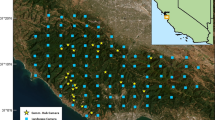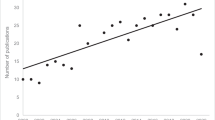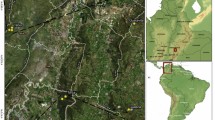Abstract
The brown marmorated stink bug, or Halyomorpha halys, is an invasive pest in North America and Europe that causes severe agricultural damage and nuisance problems for homeowners; and it is originally from China, Taiwan, and the Republic of Korea. While the natural enemy community of H. halys has been evaluated in several agroecosystems, it has not been examined where H. halys overwinters in anthropogenic structures. The aims of the current study were to evaluate 1) whether spider webs commonly found in the home and yard can successfully ensnare H. halys, 2) whether entanglement resulted in consumption by spiders inhabiting the webs, and 3) how frequently H. halys becomes entangled in webs under ambient conditions. To accomplish this, adult H. halys were introduced into webs in and near anthropogenic structures in West Virginia and Maryland, United States, and the behavior of spiders was observed for 5-min intervals at 0, 1, 2, and 24 h after introduction. In addition, a survey of webs was performed to determine the frequency with which spiders naturally capture H. halys inside buildings and in the landscape. Overall, the study found seven spider families in anthropogenic structures. Adult H. halys that were introduced into the webs of Theridiidae, Pholcidae, or Agelenidae had a greater than 50% chance of being ensnared and consumed. Adult H. halys were found naturally most often in webs of Theridiidae. Webs with a funnel or cob web architecture had the greatest probability of ensnaring H. halys, while those with orb structures resulted in the fewest caught. In the wild, 13–20% of spider webs contained dead H. halys. Our results suggest that spiders may be an important contributing factor for mortality of H. halys at overwintering sites, and spiders in or outside homes may help reduce nuisance problems caused by H. halys.





Similar content being viewed by others
References
Abram PK, Gariepy TD, Boivin G, Brodeur J (2014) An invasive stink bug as an evolutionary trap for an indigenous egg parasitoid. Biol Invasions 16:1387–1395
Abram PK, Doyon J, Brodeur J, Gariépy TD, Boivin G (2015) Susceptibility of Halyomorpha halys (hemiptera: Pentatomidae) eggs to different life stages of three generalist predators. Can Entomol 147:222–226
Anderson A (1997) Functional groups and patterns of organization in north American ant communities: a comparison with Australia. J Biogeo 24:433–460
Baldwin RL, Zhang A, Fultz SW, Abubeker S, Harris C, Connor EE, Van Hekken DL (2014) Hot topic: Brown marmorated stink bug odor compounds do not transfer into milk by feeding bug-contaminated corn silage to lactating dairy cattle. J Dairy Sci 97:1877–1884
Bergh JC, Morrison III WR, Joseph SV, Leskey TC (2017) Characterizing spring emergence of adult Halyomorpha halys using experimental overwintering shelters and commercial pheromone traps. Entomol Exp Appl. doi:10.1111/eea.12539
Blaauw BR, Polk D, Nielsen AL (2014) IPM-CPR for peaches: incorporating behaviorally-based methods to manage Halyomorpha halys and key pests in peach. Pest Manag Sci 71:1513–1522
Blackledge TA, Scharff N, Coddington JA, Szuts T, Wenzel JW, Hayashi CY, Agnarsson I (2009) Reconstructing web evolution and spider diversification in the molecular era. P Natl Acad Sci USA 106:5229–5234
Bolker BM, Brooks ME, Clark CJ, Geange SW, Poulsen JR, Stevens MHH, White J-SS (2008) Generalized linear mixed models: a practical guide for ecology and evolution. Trends Ecol Evol 24:127–135
Brose U, Jonsson T, Berlow EL, Warren P, Banasek-Richter C et al (2006) Consumer-resource body-size relationships in natural food webs. Ecology 87:2411–2417
Cornelius ML, Dieckhoff C, Hoelmer KA, Olsen RT, Weber DC, Herlihy MV, Talamas EJ, Vinyard BT, Greenstone MH (2016) Biological control of sentinel egg masses of the exotic invasive stink bug Halyomorpha halys (Stål) in mid-Atlantic USA ornamental landscapes. Biol Control 103:11–20
Craig CL (1987) The ecological and evolutionary interdependence between web architecture and web silk spun by orb web weaving spiders. Biol J Linn Soc 30:135–162
Cushing P, Ubick DP (2009) Spiders of North America: an identification manual. The American Arachnological Society, Greenville
Finke DL, Denno RF (2002) Intraguild predation diminished in complex-structured vegetation: implications for prey suppression. Ecology 83:643–652
Fogain R, Graff S (2011) First records of the invasive pest, Halyomorpha halys (hemiptera: Pentatomidae), in Ontario and Quebec. J Ent Soc Ont 142:45–48
Haye T, Fischer S, Zhang J, Gariepy TD (2015a) Can native parasitoids adopt the invasive brown marmorated stink bug, Halyomorpha halys (Heteroptera: Pentatomidae), in Europe? J Pest Sci 88:693–705
Haye T, Gariepy T, Hoelmer K, Rossi J-P, Streito J-C, Tassus X, Desneux N (2015b) Range expansion of the invasive brown marmorated stinkbug, Halyomorpha halys: an increasing threat to field, fruit and vegetable crops worldwide. J Pest Sci 88:665–673
Hoebeke ER, Carter ME (2003) Halyomorpha halys (Stål) (Heteroptera : Pentatomidae): a polyphagous plant pest from Asia newly detected in North America. Proc Ent Soc WA 105:225–237
Inkley DB (2012) Characteristics of home invasion by the brown marmorated stink bug (hemiptera: Pentatomidae). J Entomol Sci 47:125–130
Jones A (2013) Indigenous natural enemies of the invasive brown marmorated stink bug, Halyomorpha halys (hemiptera: Pentatomidae). Department of Entomology, University of Maryland, College Park, Master of Science
Jones AL, Jennings DE, Hooks CRR, Shrewsbury PM (2014) Sentinel eggs underestimate rates of parasitism of the exotic brown marmorated stink bug, Halyomorpha halys. Biol Control 78:61–66
Kalinkat G, Rall BC, Vucic-Pestic O, Brose U (2011) The allometry of prey preferences. PLoS One 6:e25937
Khrimian A, Zhang A, Weber DC, Ho HY, Aldrich JR, Vermillion KE, Siegler MA, Shirali S, Guzman F, Leskey TC (2014) Discovery of the aggregation pheromone of the brown marmorated stink bug (Halyomorpha halys) through the creation of stereoisomeric libraries of 1-bisabolen-3-ols. J Nat Prod 77:1708–1717
Lara J, Pickett C, Ingels C, Haviland DR, Grafton-Cardwell E, Doll D, Bethke J, Faber B, Dara SK, Hoddle M (2016) Biological control program is being developed for brown marmorated stink bug. CA Agric 70:15–23
Lee D-H (2015) Current status of research progress on the biology and management of Halyomorpha halys (hemiptera: Pentatomidae) as an invasive species. Appl Entomol Zool 50:277–290
Lee D-H, Leskey TC (2015) Flight behavior of foraging and overwintering brown marmorated stink bug, Halyomorpha halys (hemiptera: Pentatomidae). B Entomol Res 105:566–573
Lee D-H, Short BD, Joseph SV, Bergh JC, Leskey TC (2013) Review of the biology, ecology, and management of Halyomorpha halys (hemiptera: Pentatomidae) in China, Japan, and the Republic of Korea. Environ Entomol 42:627–641
Lee D-H, Cullum JP, Anderson JL, Daugherty JL, Beckett LM, Leskey TC (2014) Characterization of overwintering sites of the invasive brown marmorated stink bug in natural landscapes using human surveyors and detector canines. PLoS One 9:e91575
Lemelin RH, Yen A (2015) Human–spider entanglements: understanding and managing the good, the bad, and the venomous. Anthrozoos 28:215–228
Leskey TC, Hamilton GC, Nielsen AL, Polk DF, Rodriguez-Saona C, Bergh JC, Herbert DA, Kuhar TP, Pfeiffer D, Dively GP, Hooks CRR, Raupp MJ, Shrewsbury PM, Krawczyk G, Shearer PW, Whalen J, Koplinka-Loehr C, Myers E, Inkley D, Hoelmer KA, Lee D-H, Wright SE (2012a) Pest status of the brown marmorated stink bug, Halyomorpha halys in the USA. Outlooks on Pest Management 23:218–226
Leskey TC, Wright SE, Short BD, Khrimian A (2012b) Development of behaviorally-based monitoring tools for the brown marmorated stink bug (Heteroptera: Pentatomidae) in commercial tree fruit orchards. J Entomol Sci 47:76–85
Leskey TC, Short BD, Butler BR, Wright SE (2012c) Impact of the invasive brown marmorated stink bug, Halyomorpha halys (Stål), in mid-Atlantic tree fruit orchards in the United States: case studies of commercial management. Psyche 2012:1–14
Leskey TC, Agnello A, Bergh CJ, Dively GP, Hamilton GC, Jentsch P, Khrimian A, Krawczyk G, Kuhar TP, Lee D-H, Morrison WR III, Polk DF, Rodriguez-Saona C, Shearer PW, Short BD, Shrewsbury PM, Walgenbach JF, Weber DC, Welty C, Whalen J, Wiman NG, Zaman F (2015a) Attraction of the invasive Halyomorpha halys (hemiptera: Pentatomidae) to traps baited with semiochemical stimuli across the United States. Environ Entomol 44:746–756
Leskey TC, Khrimian A, Weber DC, Aldrich JR, Short BD, Lee D-H, Morrison WR III (2015b) Behavioral responses of the invasive Halyomorpha halys (Stål) to traps baited with stereoisomeric mixtures of 10,11-epoxy-1-bisabolen-3-ol. J Chem Ecol 41:418–429
Mansour F, Richman DB, Whitcomb WH (1983) Spider management in agroecosystems: habitat manipulation. Envrion Manage 7:43–49
Marc P, Canard A (1997) Maintaining spider biodiversity in agroecosystems as a tool in pest control. Agric Ecosyst Environ 62:229–235
Marc P, Canard A, Ysnel F (1999) Spiders (Araneae) useful for pest limitation and bioindication. Agric Ecosyst Environ 74:229–273
Martinson HM, Venugopal PD, Bergmann EJ, Shrewsbury PM, Raupp MJ (2015) Fruit availability influences the seasonal abundance of invasive stink bugs in ornamental tree nurseries. J Pest Sci 88:461–468
Michalko R, Pekar S (2015) The biocontrol potential of Philodromus (Araneae, Philodromidae) spiders for the suppression of pome fruit orchard pests. Biol Control 82:13–20
Morrison WR III, Cullum JP, Leskey TC (2015) Evalulation of trap designs and deployment strategies for capturing Halyomorpha halys (hemiptera: Pentatomidae). J Econ Entomol 108:1683–1692
Morrison WR III, Lee D-H, Short BD, Khrimian A, Leskey TC (2016a) Establishing the behavioral basis for an attract-and-kill strategy to manage the invasive Halyomorpha halys in apple orchards. J Pest Sci 89:81–96
Morrison WR III, Mathews CR, Leskey TC (2016b) Frequency, efficiency, and physical characteristics of predation by generalist predators of brown marmorated stink bug (hemiptera: Pentatomidae) eggs. Biol Control 97:120–130
Morrison WR III, Poling B, Leskey TC (2016c) The consequences of sublethal exposure to insecticide on the survivorship and mobility of Halyomorpha halys (hemiptera: Pentatomidae). Pest Manag Sci 73:389–396
Nentwig W (1982) Why do only certain insects escape from a spider’s web? Oecologia 83:412–417
Nentwig W (1983) The prey of web-building spiders compared with feeding experiments (Araneae: Araneidae, Linyphiidae, Pholcidae, Agelenidae). Oecologia 56:132–139
Nielsen AL, Hamilton GC (2009a) Life history of the invasive species Halyomorpha halys (hemiptera: Pentatomidae) in northeastern United States. Ann Entomol Soc Am 102:608–616
Nielsen AL, Hamilton GC (2009b) Seasonal occurrence and impact of Halyomorpha halys (hemiptera: Pentatomidae) in tree fruit. J Econ Entomol 102:1133–1140
Nielsen AL, Dively G, Pote JM, Zinati G, Mathews C (2016a) Identifying a potential trap crop for a novel insect pest Halyomorpha halys (hemiptera: Pentatomidae), in organic farms. Environ Entomol, in press. doi:10.1093/ee/nvw006
Nielsen AL, Fleischer S, Chen S (2016b) Coupling developmental physiology, photoperiod, and temperature to model phenology and dynamics of an invasive Heteropteran, Halyomorpha halys. Frontiers in Physiology, in press. doi:10.3389/fphys.2016.00165
Nyffeler M, Sunderland KD (2003) Composition, abundance and pest control potential of spider communities in agroecosystems: a comparison of European and US studies
Ogburn EC, Bessin R, Dieckhoff DR, Grieshop M, Hoelmer KA, Mathews C, Moore J, Nielsen AL, Poley K, Pote JM, Rogers M, Welty C, Walgenbach JF (2016) Natural enemy impact on eggs of the invasive brown marmorated stink bug, Halyomorpha halys (Stål) (hemiptera: Pentatomidae), in organic agroecosystems: a regional assessment. Biol Control 101:39–51
Owens DR, Herbert DA, Dively GP, Reisig DD, Kuhar TP (2013) Does feeding by Halyomorpha halys (hemiptera: Pentatomidae) reduce soybean seed quality and yield? J Econ Entomol 106:1317–1323
R Core Development Team (2015) R: A language and environment for statistical computing. R Foundation for Staistical Computing, http://www.R-project.org/, Vienna, Austria
Rice KB, Bergh CJ, Bergmann EJ, Biddinger DJ, Dieckhoff C, Dively G, Fraser H, Gariepy T, Hamilton G, Haye T, Herbert A, Hoelmer K, Hooks CR, Jones A, Krawczyk G, Kuhar T, Martinson H, Mitchell W, Nielsen AL, Pfeiffer DG, Raupp MJ, Rodriguez-Saona C, Shearer P, Shrewsbury P, Venugopal PD, Whalen J, Wiman NG, Leskey TC, Tooker JF (2014) Biology, ecology, and management of brown marmorated stink bug (hemiptera: Pentatomidae). Journal of Integrated Pest Management 5:1–13
Riechert SE, Lockley T (1984) Spiders as biological control agents. Annu Rev Entomol 29:299–320
Rypstra AL (1982) Building a better insect trap; an experimental investigation of prey capture in a variety of spider webs. Oecologia 52:31–36
Rypstra AL, Buddle CM (2013) Spider silk reduces insect herbivory. Biol Letters 9:20120948
Rypstra AL, Carter PE, Balfour RA, Marshall SD (1999) Architectural features of agricultural habitats and their impact on the spider inhabitants. J Arachnol 27:371–377
Schmidt MH, Roschewitz I, Thies C, Tscharntke T (2005) Differential effects of landscape and management on diversity and density of ground-dwelling farmland spiders. J Appl Ecol 42:281–287
Soergel DC, Ostiguy N, Fleischer SJ, Troyer RR, Rajotte EG, Krawczyk G (2015) Sunflower as a potential trap crop of Halyomorpha halys (hemiptera: Pentatomidae) in pepper fields. Environ Entomol 44:1581–1589
Talamas E, Buffington M, Hoelmer K (2013) New synonymy of Trissolcus halyomorphae Yang. J Hymenopt Res 33:113–117
Talamas EJ, Herlihly MV, Dieckhoff C, Hoelmer K, Buffington M, Bon M-C, Weber DC (2015) Trissolcus japonicus (Ashmead) (hymenoptera: Scelionidae) emerges in North America. J Hymenopt Res 43:119–128
Weber DC, Leskey TC, Walsh GC, Khrimian A (2014) Synergy of aggregation pheromone with methyl (E,E,Z)-2,4,6-decatrienoate in attraction of Halyomorpha halys (Hemiptera: Pentatomidae). J Econ Entomol 107:1061–1068
Wermelinger B, Wyniger D, Forster B (2008) First records of an invasive bug in Europe: Halyomorpha halys stal (Heteroptera: Pentatomidae), a new pest on woody ornamentals and fruit trees? Mit Sch Entomol Ges 81:1–8
Wiman NG, Parker JE, Rodriguez-Saona C, Walton VM (2015) Characterizing damage of brown marmorated stink bug (hemiptera: Pentatomidae) in blueberries. J Econ Entomol 108:1156–1163
Wise DH, Snyder WE, Tuntibunpakul P, Halaj J (1999) Spiders in decomposition food webs of agroecosystems: theory and evidence. J Arachnol 27:363–370
Yang Z-Q, Yao Y-X, Qiu L-F, Li Z-X (2009) A new species of Trissolcus (hymenoptera: Scelionidae) parasitizing eggs of Halyomorpha halys (Heteroptera: Pentatomidae) in China with comments on its biology. Ann Entomol Soc Am 102:39–47
Zhu G, Bu W, Gao Y, Liu G (2012) Potential geographic distribution of brown marmorated stink bug invasion (Halyomorpha halys). PLoS One 7:e31246
Zschokke S, Herberstein ME (2005) Laboratory methods for maintaining and studying web-building spiders. J Arachnol 33:205–213
Acknowledgements
The authors would like to thank Morgan Douglas and Nate Brandt for their excellent technical assistance in the laboratory and field. This research was funded, in part, by a USDA-NIFA SCRI CAP Grant#2011-51181-30937.
Author information
Authors and Affiliations
Corresponding author
Electronic Supplementary Material
ESM 1
(DOCX 57 kb)
Rights and permissions
About this article
Cite this article
Morrison, W.R., Bryant, A.N., Poling, B. et al. Predation of Halyomorpha halys (Hemiptera: Pentatomidae) from Web-Building Spiders Associated with Anthropogenic Dwellings. J Insect Behav 30, 70–85 (2017). https://doi.org/10.1007/s10905-017-9599-z
Revised:
Accepted:
Published:
Issue Date:
DOI: https://doi.org/10.1007/s10905-017-9599-z




